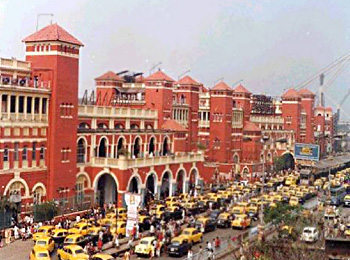 Howrah District, said to be the twin of Kolkata, has a rich history that dates back almost 500 years. It is the smallest district in West Bengal situated between 22 degrees 12 minutes and 22 degrees 46 minutes morth latitude and 88 degree 22 minutes and 87 degrees 50 minutes east longitude. It is bounded on the north by the Arambagh and Serampore subdivisions of the Hooghly district; on the east by Kolkata and the Barrackpur, Alipur and Diamond Harbor subdivisions of the 24-Parganas district; on the south by the Tamluk subdivision of the Midnapur district; and on the west partly by the Tamluk and Ghatal subdivisions of the latter district and partly by the Arambagh subdivision of the Hooghly district. The boundaries are partly natural and partly artificial.
Howrah District, said to be the twin of Kolkata, has a rich history that dates back almost 500 years. It is the smallest district in West Bengal situated between 22 degrees 12 minutes and 22 degrees 46 minutes morth latitude and 88 degree 22 minutes and 87 degrees 50 minutes east longitude. It is bounded on the north by the Arambagh and Serampore subdivisions of the Hooghly district; on the east by Kolkata and the Barrackpur, Alipur and Diamond Harbor subdivisions of the 24-Parganas district; on the south by the Tamluk subdivision of the Midnapur district; and on the west partly by the Tamluk and Ghatal subdivisions of the latter district and partly by the Arambagh subdivision of the Hooghly district. The boundaries are partly natural and partly artificial.
The name itself is possibly derived from a village named Harirah which was located in or about the site of modern day Howrah City. Venetian explorer Ceasare Federici was the first European who mentioned a place called Bator in his journal in 1578 AD which is identifiable with the modern day place around the Howrah City. The Bengal Council of the British East India Company, on the accession of the Emperor Farruksiyar to the throne of Delhi in AD 1713, sent a deputation to him praying for a settlement of the villages `Salica` (Salkia), `Harirah`(Howrah), `Cassundeah`(Kasundia), `Ramkrishnopoor` (Ramkrishnapur), and `Battar`(Betor) to the west of Bhagirathi river and once the settlement was made in favour of the British East India Company the places were quickly adopted as exit and entry point of sea faring business hubs and the modernisation of Howrah city as we know it now, began.
The Howrah Railway Terminus came up in 1854 and in 1862 the first municipal administration started functioning though the modern day Corporation as we see it now came into being in 1980 when the Howrah Act, 1980 was implemented. It was transferred from the Burdwan Division to the Presidency Division under Government of West Bengal Notification No. 999-G.A. dated March 4, 1963.



















